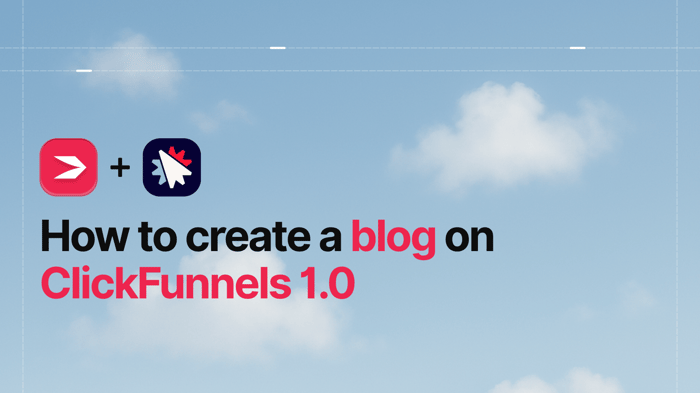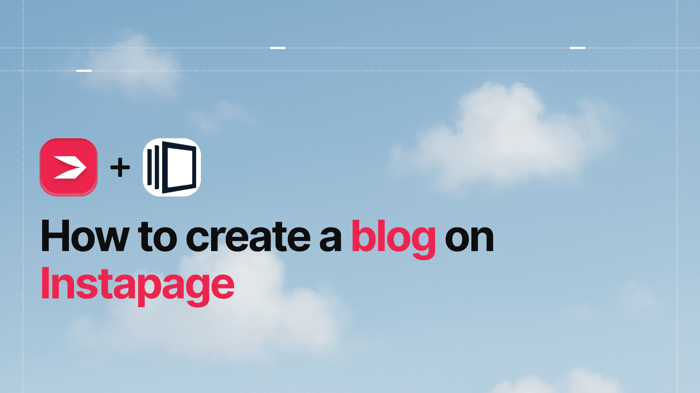Instapage and ClickFunnels are web platforms that can be used for creating landing pages. However, while Instapage is a proper landing page builder and nothing other than that, ClickFunnels is much more than a landing page builder.
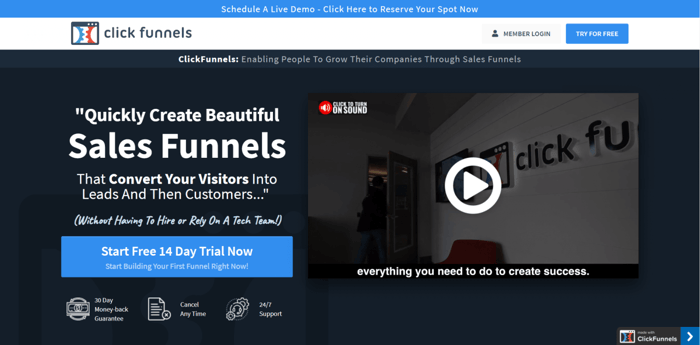
ClickFunnels is primarily focused on sales funnels, which are complex and require a large variety of tools to build and run. This is unlike specialized landing page builders concentrated exclusively on one thing. As ClickFunnels includes a variety of tools, you may find it a bit overwhelming if you’re just looking for a landing page platform. However, the important part is that you can build solid landing pages with ClickFunnels as well since landing pages are an integral part of sales funnels.
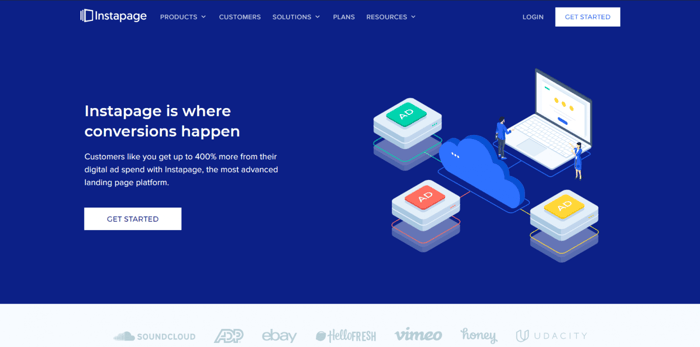
As a specialized landing page platform, Instapage’s mission is to enable you to build and run elegant and conversion-optimized landing pages. It’s not exactly meant to be used as a self-contained tool. Instapage helps you solve only one piece of the sales and marketing puzzle. For the rest, such as email marketing and payment processing, you need to find other tools. In short, it works best as a part of a larger system consisting of different types of software.
In this Instapage vs. ClickFunnels guide, we’ll compare these web platforms and see their upsides and downsides. We’ll say a few words about what they’re good at as well as who these platforms are designed for. So, without further ado, let’s get to work.
Table of Contents
Pricing
One feature common to both platforms’ pricing systems is the 14-day free trial. Apart from this, they differ in many things.
Instapage
Overview
For starters, unlike ClickFunnels, Instapage includes only two pricing plans:
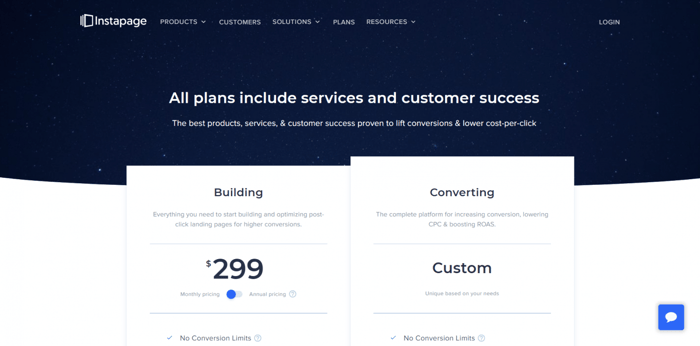
The annual pricing costs $2,388/year, which equals $199/month, saving you hundreds of dollars in the long run if you can afford the upfront costs. The Converting plan pricing is custom, depending on the features you choose to include.
The Building Plan
Some of the highlights of the Building plan are:
- A/B testing
- Ability to build AMP landing pages
- Advanced conversion analytics
- Instablocks
The Converting Plan
The Converting plan includes everything from the Building plan, plus unique features like:
- Advanced and custom integrations
- Advanced marketing personalization tools (such as 1:1 Ad-to-Page Personalization)
- Heatmaps
- Custom feature implementation
ClickFunnels
Overview
The ClickFunnels pricing system consists of three pricing plans:

In contrast to Instapage, ClickFunnels doesn’t offer annual pricing, so these are the only available pricing options.
The ClickFunnels Plan
Some of the noteworthy features the ClickFunnels plan includes are:
- Three payment gateways
- Access to FunnelFlix (a video training platform that contains volumes of invaluable sales and marketing resources)
The ClickFunnels Platinum Plan
The ClickFunnels Platinum includes:
- Unlimited follow-up funnels (essentially, marketing automation tools)
- Ability to connect nine custom domains
- Weekly virtual hackathons
The TwoCommaClubX Plan
Through the TwoCommaClubX plan, ClickFunnels offers the following perks:
- Access to 27 payment gateways
- VIP phone support
- Access to even more training, courses, and expert materials
Upsides and Downsides
Affordability
Instapage is expensive, period. Even users who love this platform or believe it’s cost-effective think it’s pricey. The high starting cost ($299/month) is its biggest disadvantage.
Pricing Options
Another downside is that Instapage offers very limited pricing options: it’s either $299/month or a custom price (which, as you can imagine, can be pretty high). There is nothing in between and nothing for users with limited budgets.
Annual Billing
On the other hand, Instapage offers an annual subscription, which, as we already suggested, significantly reduces your yearly costs and gives this platform the upper hand over ClickFunnels.
Number of Landing Pages
If we compare these two platforms’ pricing systems at the elementary level, we’ll see that ClickFunnels offers more overall (in terms of quantity) for less money.
For instance, the ClickFunnels plan allows you to create up to 100 pages. The Instapage Building plan, on the other hand, lets you have only up to 30 “published landing page experiences,” as Instapage calls them. They may not be the simple landing pages you build in ClickFunnels, but $97/month (ClickFunnels) is considerably less than $299/month (Instapage).
So, someone who just wants decent-looking landing pages with acceptable features would probably not think too hard when choosing between the two platforms if price was a main priority.
The next tier on the pricing ladder – the ClickFunnels Platinum plan – comes with an unlimited number of pages and it’s still a couple of dollars cheaper than the Instapage Building plan (not counting the annual discount).
So, does all this mean that Instapage is just an overpriced platform? Not quite and it’ll become clear why later.
Email Marketing Automation
One often-heard critique of ClickFunnels is that the basic ClickFunnels plan doesn’t include email marketing automation, which most people consider an elementary sales funnel feature. This is a general drawback of ClickFunnels and not so much a disadvantage vis-à-vis Instapage. Nevertheless, it’s something you need to keep in mind when considering whether to opt for the basic ClickFunnels plan or not.
Important Features
Instapage
Page Editor, Templates, and Customization
Instapage and ClickFunnels both offer good drag-and-drop page editors. They’re simple to understand and easy to use. The ClickFunnels editor is even simpler than the one found in Instapage. However, what makes the Instapage page editor special is that it’s free-form, meaning that the elements on your page are not locked in their containers. You can move them around the page and place them exactly where you want.
Considering that the majority of drag-and-drop editors are not of this type, this can be a big plus for Instapage, especially for users who understand design and aesthetics, as well as for those who want more creative freedom and control.
Instapage offers a bunch of design templates and customization options. They are feature-rich and have great modern designs. There are over 20 categories of templates, grouped based on their use: demo request, event registration, product launch, etc.
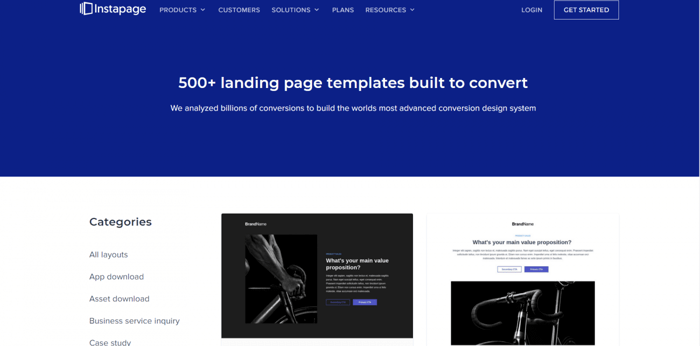
As far as customization is concerned, the editor allows you to add and edit:
- Headlines
- Paragraphs
- Forms
- Buttons
- Timers
- HTML blocks
- Footers
- Logos
- Background
- Colors
- Text
Instablocks
Instablocks are reusable content block templates. You can choose from more than 30 types or use global blocks. Global blocks allow you to update as many pages as you want from one place with one click.
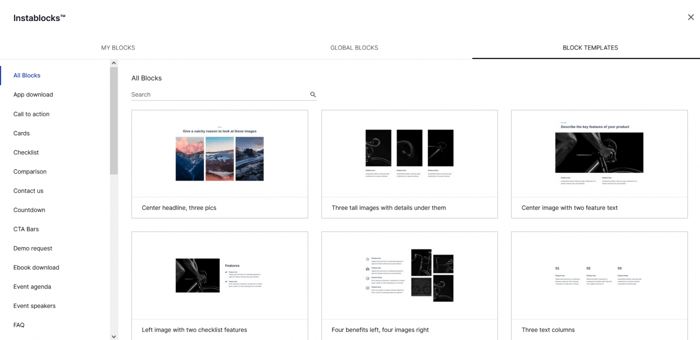
Hosting and Speed
All Instapage landing pages are hosted on Amazon Web Services, which kind of guarantees reliability and extremely high uptime. In addition to this, thanks to its native Thor Render Engine system, built-in CDN support, the ability to build AMP landing pages, the implementation of Google’s recommendations for fast page load time, and the SSL certificates, in Instapage you get secure and lightning-fast landing pages optimized for conversion.
Heatmaps
Heatmaps are an analytics tool. More precisely, they belong to the realm of data visualization and they can be of crucial importance in terms of audience behavior patterns and page interaction analysis.
The Instapage heatmaps track three facets of users’ page interaction: mouse movement, clicking, and scrolling. They communicate the areas of your pages where visitors spend the most time, where they click, and how deep they usually scroll your page. This gives you precious insights into the behavior of different audiences and allows you to adjust your landing pages so they’re better optimized for conversion.
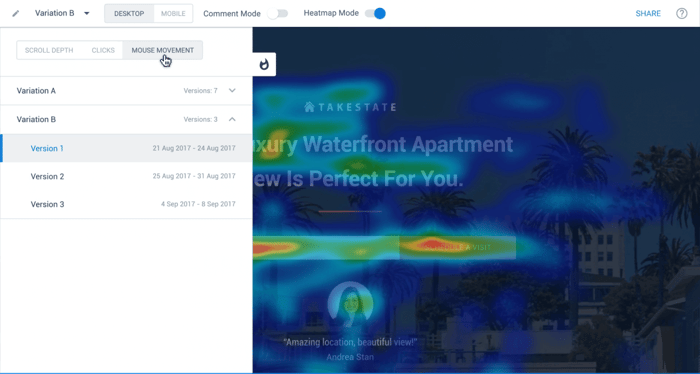
ClickFunnels
Simple Landing Pages
In ClickFunnels you can create very simple landing pages, which is great because that’s how landing pages are supposed to be: simple. However, keep in mind that simplicity usually means fewer features, which is not everybody’s cup of tea.
Despite not providing all the design and customization possibilities found in Instapage, ClickFunnels offers a good number of design and editing options as well. In ClickFunnels, you can add and edit:
- Templates
- Headlines
- Paragraphs
- Images
- Image popups
- Videos
- Colors
- Custom CSS
- Buttons
- Padding
- Logos
One difference compared to Instapage is that the ClickFunnels landing pages are more salesy. Also, design-wise, they’re not as up-to-the-minute as those built on Instapages. However, you have to take into account that landing pages are not the only type of pages you can build on ClickFunnels, so it’s not too surprising that its landing pages aren’t exactly the best-looking on the market.
Affiliate Program
The ClickFunnels affiliate program is one of the most popular on the market. ClickFunnels provides you with the opportunity to promote the platform through referral links, so whenever a new user makes a purchase through your promotional efforts, you get a cut from it.
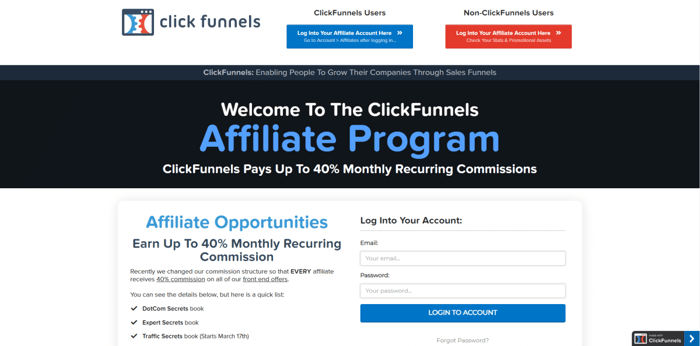
One of the big pluses of the ClickFunnels affiliate program is that the platform offers recurring commissions. This means that if the new ClickFunnels members (who subscribed through you) keep paying their monthly fees, you receive a commission on a regular monthly basis.
Sales Funnels
Due to its nature, this is the area where ClickFunnels excels.
The platform offers over 100 sales funnel templates. Using these templates, you can build different types of sales funnels like lead generation, webinar, launch, and follow-up funnels.
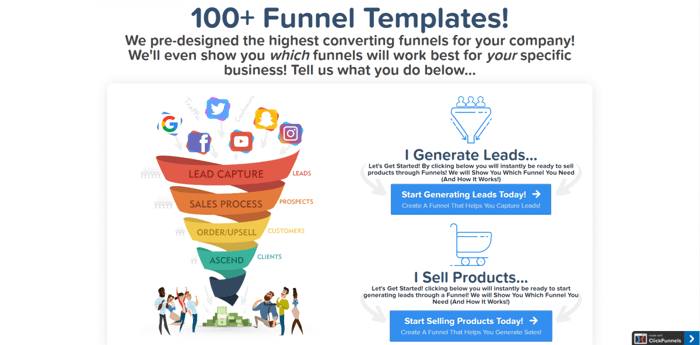
ClickFunnels allows you to add pages and membership sites to your sales funnel or remove the existing ones. You can customize the look of a sales funnel and add a follow-up funnel to ensure that you keep your communication with your audience alive even when they’ve already subscribed. The follow-up funnels let you broadcast email and text messages and track stats like the identity of users who check your emails, the products newly-generated leads buy from you, and the earnings that your email marketing brings you.
There’s no doubt that when it comes to sales funnels, ClickFunnels is one of the best on the market. Simply put, if you’re all about creating sales funnels, ClickFunnels is definitely your friend.
High-Quality Training Material
Another huge advantage of ClickFunnels is how much emphasis it puts on training and educating the members of its community. Its video training platform FunnelFlix alone contains so much invaluable material, and it’s only a part of what ClickFunnels offers in terms of sales and marketing training, guidance, and education.
Then there are the virtual hackathons. These are weekly live training sessions that provide expert guidance on how to build and run successful sales funnels to boost your business.
On top of this, there’s the exclusive training content that you get access to only if you subscribe to the most expensive TwoCommaClubX plan. However, it contains coaching by the ClickFunnels co-founder Russel Brunson, so it could be argued that if you’re already on that level of experience and understanding of ClickFunnels, and you have the money to afford this subscription plan, it’s a coaching program that’s worth your time, efforts, and money.
Integrations
Instapage
When it comes to platform extensibility, with 120 integrations and counting, Instapage stands pretty well. The official list of integrations includes email marketing, analytics, e-commerce, call tracking, marketing automation, CRM, and more categories of apps. It includes such prominent names as Marketo, Pardot, HubSpot, ActiveCampaign, Mailchimp, ConvertKit, AWeber, Salesforce, Shopify, Google, Facebook, Zapier, and many others.
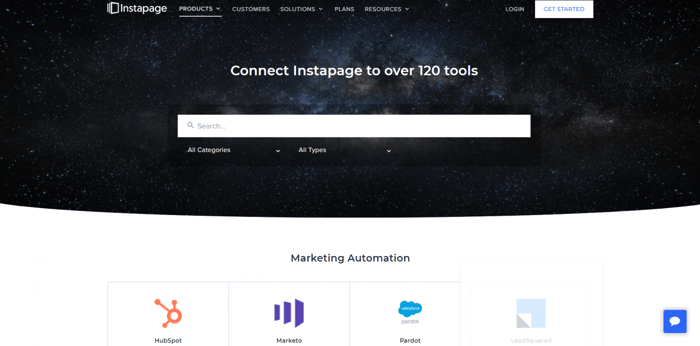
The great news is that the full number of possible Instapage integrations can be much larger. One option is to integrate a ton of other apps through Zapier. Another is to extend Instapage’s range of functionalities through embed codes. This is a feature available starting with the Building plan and it’s an extremely convenient way of adding new tools to your sales and marketing toolkit.
As an example, thanks to this integration method, you can extend Instapage with a cool and modern blogging tool like DropInBlog, a functionality that is otherwise completely missing from Instapage. It makes adding a blog to Instapage as well as generally expanding the platform’s capacities a fairly simple and short process.
ClickFunnels
ClickFunnels integrates with different payment gateways, email (SMTP) service providers, autoresponders, webinar apps, messaging software, sales tax apps, SMS applications, and more. On its list of integrations, you’ll find Stripe, PayPal, Constant Contact, Drip, Mailchimp, Zoom, WebinarJam, ZenDirect, Shopify, Twilio, Zapier (and a host of other apps through Zapier), and many of the apps found among the Instapage integrations.
Which One Is Better?
By all accounts, ClickFunnels was built virtually as a self-sufficient one-stop platform. Hence, the many built-in features but limited choice of integrations (only compared to Instapage).
Instapage leaves a lot more room for integrations, probably due to it being focused only on landing pages. If users want additional functionalities, they can get them through all the various apps compatible with this platform.
So, it all comes down to whether you prefer to have access to a ton of tools right off the bat or to get just the tools you need for building and optimizing landing pages, and then be able to choose from a host of additional functions as you see fit. Instapage embodies the second approach while ClickFunnels and similar all-in-one platforms embody the first.
Speaking of which, it is worth noting that all-in-one platforms are not always a good thing. ClickFunnels, for instance, is considered to be bloated, buggy, and at times a bit slow and clunky exactly because of all the tools it includes. Of course, the enormous number of ClickFunnels customers tells a different story – a story of success and customer satisfaction. However, keep in mind the potential issues you may encounter along the way.
Who Are These Platforms For?
According to a study of 1,013 companies that use Instapage and a study of 8,807 ClickFunnels customers, it turns out that there’s not much that separates these two platforms in terms of who uses them. The bulk of the companies that use them are small companies. Another shared statistics is that they’re both extensively used in the marketing and advertising niche.
However, these stats don’t tell the full story. The whole point of Instapage and ClickFunnels is to allow their customers to attract users who then take a specific action, such as a sign-up or purchase. They both have been successful at doing this, but they’ve been doing it in different ways and catering to slightly different audiences.
Instapage
Instapage can be a good choice if you already have subscriptions to email marketing, CRM, and payment processing service providers. Additionally, it’s probably a bit more suitable for larger companies that have specialized advertising teams rather than for regular end-users.
Instapage works great for PPC (pay-per-click) marketing and it’s not terribly easy to get your head around. For exactly these reasons, it’s not ideal for inexperienced marketers and beginners. Its pricing system and beginning costs also make it unsuitable for absolute beginners.
ClickFunnels
ClickFunnels is primarily for users who need a platform that allows them to create not just landing pages, but a full sales funnel experience in one place. So if, instead of having multiple subscriptions to various platforms/apps, you want to take a shortcut to building and managing sales funnels by doing everything from one account on one platform, then ClickFunnels is the way to go.
ClickFunnels caters to a much wider audience in terms of tech-savviness and experience compared to Instapage. It simplifies building and running sales funnels so much that many different types of users, regardless of their experience and technical knowledge, can get the hang of it in a relatively short time.
This is not the same as saying that you can become a sales funnel expert in no time or that you’ll be able to use every aspect of the platform with ease and great success. In this regard, ClickFunnels resembles WordPress: it can be easy or difficult, simple or complex, all at the same time. It was built in such a way that it can work for newbies and experts as well.
From a budget perspective, ClickFunnels allows you to start at a much lower price than Instapage, which can be very convenient for many newcomers to online sales and marketing.
All in all, ClickFunnels is suitable for a wider array of audiences, but if you just need a landing page builder and nothing more, it could be overkill.
Over and Out
This Instapage vs. ClickFunnels comparison presented some of the most important facets and features of these two platforms. We hope we managed to point out their differences, strengths, and weaknesses, as well as the contexts they would work best in. So, which tickles your fancy more? We hope this read gave you a straightforward answer to this question.


